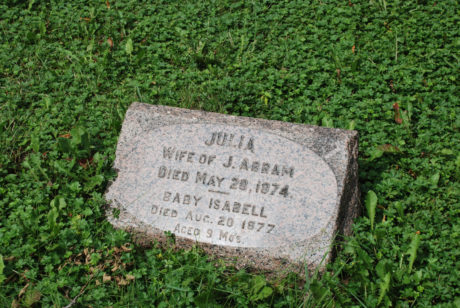
By SUE HUNTER WEIR
Julia Abrams was just 22 years old when she died after giving birth in 1874. Julia is only one of 110 women buried in Minneapolis Pioneers and Soldiers Memorial Cemetery who either died during childbirth or shortly afterward from complications caused by their pregnancies. There are undoubtedly more but since doctors used a variety of words to describe the cause of death, it is hard, if not impossible, to say how many. “Peritonitis” might refer to an infection but it might also refer to something like appendicitis.
The women’s ages ranged from 16 to 53. Anna Griffin was the youngest of the women; she was barely 16 years old when she died; her baby died from malnutrition 15 days later. Mary Zustiak was 53 when she died in 1915. The majority of the women were between the ages of 21 and 39—the ages that we typically think of as child-bearing age. According to cemetery records, 82 of the 110 women were immigrants, the majority of them from Norway and Sweden (34 from Norway, 31 from Sweden). A handful were from Denmark, Canada, Germany, England and Austria/Slovakia. Most of the women were working-class. Most of them were undoubtedly poor. Half of the deaths occurred in the 1880s, years that correspond to the large increase in the number of Scandinavian immigrants.
The connection between a mother’s health and that of her baby seems clear. Forty-one of the women delivered babies who would not live to see their first birthdays. Eight of their babies were stillborn. Ten of them died from marasmus or inanition, words that have been forgotten or at least are rarely used in the United States any more. Both words refer to some form of malnutrition, and although they are no longer a common cause of death in the United States that was not always the case. Marasmus describes a condition where an infant’s weight is less than 60% of normal, and inanition refers to exhaustion that is caused by inadequate nutrition. Lack of access to clean water was also an issue for many families at a time when more than 90% of births took place at home. Overcrowding contributed to the spread of infectious diseases like meningitis and a variety of respiratory illnesses.
In 1910, there were 124 deaths for every 1,000 live births, and children under the age of five accounted for one quarter of all of the nation’s deaths. Change came slowly but it came. In 1913, the federal government established the Children’s Bureau, which was housed under the Department of Labor. Its goal was to assess and meet the needs of mothers and their children—needs that they viewed as inseparable. The Bureau received as many as 125,000 letters a year from women, mostly working class, many living in isolated areas, asking for advice about subjects that people just didn’t talk about. Many of the women were pregnant and terrified at the prospect of giving birth. They needed both advice and reassurance. Help came in the form of a publication titled “Prenatal Care.” Between 1914 and 1921, more than 1,500,000 copies were distributed, and, in 1965, the pamphlet was still in print and it was reported that the mothers of one in three babies had a copy.
In addition to providing needed information, the women who ran the Bureau played an important part in shaping government programs and policies, many of which are still in place. In 1922, the Sheppard and Towner Maternity and Infant Protection Act passed, the first of many government initiatives dedicated to improving maternity and infant care.
Today, the infant mortality rate in the United States is 5.64 deaths per 1,000 live births. The maternal mortality rate is 20 deaths per 100,000 births. Other industrialized countries have lower rates and there are still many issues, including racial inequities, that need to be addressed. But the Bureau and other like-minded reformers proved that health education and programs that support maternal and infant health save lives.









